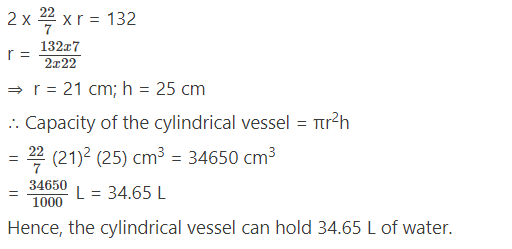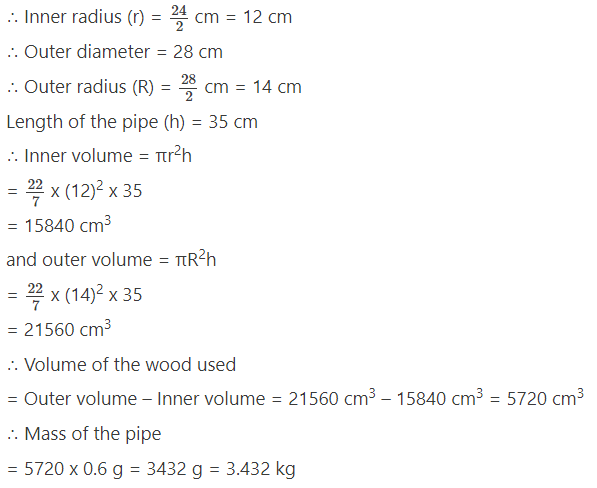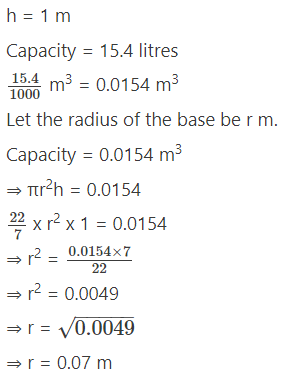Gujarat Board Textbook Solutions Class 9 Maths Chapter 13 Surface Areas and Volumes Ex 13.6
Gujarat Board Textbook Solutions Class 9 Maths Chapter 13 Surface Areas and Volumes Ex 13.6
GSEB Solutions Class 9 Maths Chapter 13 Surface Areas and Volumes Ex 13.6
Question 1.
The circumference of the base of a cylindrical vessel is 132 cm and its height is 25 cm. How many litres of water can it hold? (1000 cm3 = 1L)
Solution:
Let the base radius of the cylindrical vessel be r cm. Then, the circumference of the base of the cylindrical vessel = 2πr cm.
According to the question,
2πr = 132

Question 2.
The inner diameter of a cylindrical wooden pipe is 24 cm and its outer diameter is 28 cm. The length of the pipe is 35 cm. Find the mass of the pipe, if 1 cm3 of wood has a mass of 0.6 g.
Solution:
∴ Inner diameter = 24 cm

Question 3.
A soft drink is available in two packs (i) a tin can with a rectangular base of length 5 cm and width 4 cm, having a height of 15 cm and (ii) a plastic cylinder with a circular base of diameter 7 cm and height 10 cm. Which container has greater capacity and by how much?
Solution:
(i) For tin can
1 = 5 cm
b = 4 cm
h = 15 cm
Capacity = l x b x h
= 5 x 4 x 15 cm3 = 300 cm3
(ii) For plastic cylinder
Diameter = 7 cm
∴ Radius (r) = 7/2 cm
Height (h) = 10 cm
∴ Capacity = πr2h
= 22/7 x (7/2)2x 10 = 385 cm2
Clearly the second container i.e., a plastic cylinder has greater capacity than the first container i.e., a tin can by 385 – 300 = 85 cm3.
Question 4.
If the lateral surface of a cylinder is 94.2 cm2 and its height is 5 cm, then find (i) radius of its base (ii) its volume. (Use π = 3.14)
Solution:
(i) Let the radius of the base of the cylinder be r cm.
h = 5 cm
Lateral surface = 94.2 cm2
⇒ 2πrh = 94.2
⇒ 2 x 3.14 x r x 5 = 94.2

(ii) r = 3 cm
h = 5 cm
∴ Volume of the cylinder = πr2h
= 3.14 x (3)2 x 5 = 141.3 cm3
Question 5.
It costs ₹ 2200 to paint the inner curved surface of a cylindrical vessel 10 m deep. If the cost of painting is at the rate of ₹ 20 per m2, find
(i) inner curved surface area of the vessel,
(ii) radius of the base,
(iii) capacity of the vessel.
Solution:
(i) Inner curved surface area of the vessel
= 2200/20 = 110 m2

(iii) r = 1.75 m
h = 10 m
∴ Capacity of the vessel = πr2h
= 22/7 x (1.75)2 x 10
= 96.25 m3
Hence, the capacity of the vessel is 96.25 m3 (or 96.25 kL).
Question 6.
The capacity of a closed cylindrical vessel of height 1 m is 15.4 litres. How many square metres of the metal sheet would be needed to make it?
Solution:

∴ Total surface area = 2πrh + 2πr2
= 2 x 22/7 x 0.07 x 1 + 2 x 22/7 x (0.07)2
= 0.44 + 0.0308 = 0.4708 m2
Hence, 0.4708 m2 of the metal sheet should be needed.
Question 7.
A lead pencil consists of a cylinder of wood with a solid cylinder of graphite filled in the interior. The diameter of the pencil is 7 mm and the diameter of the graphite is 1 mm. If the length of the pencil is 14 cm, find the volume of the wood and that of the graphite.
Solution:

Question 8.
A patient in a hospital is given soup daily in a cylindrical bowl of a diameter 7 cm. If the bowl is filled with soup to a height of 4 cm, how much soup the hospital has to prepare daily to serve 250 patients?
Solution:
Diameter = 7 cm
∴ Radius (r) = 7/2 cm
Height (h) = 4 cm
∴ Volume of soup in the cylindrical bowl = πr2h
= 22/7 x (7/2)2 x 4 cm3 = 154 cm3
∴ Volume of soup to be prepared daily to serve 250 patients
= 154 x 250 cm3 = 38500 cm3 (or 38.5 L)
Hence, the hospital has to prepare 38500 cm3 (or 38.5 L) of soup daily to serve 250 patients.
Follow on Facebook page – Click Here
Google News join in – Click Here
Read More Asia News – Click Here
Read More Sports News – Click Here
Read More Crypto News – Click Here